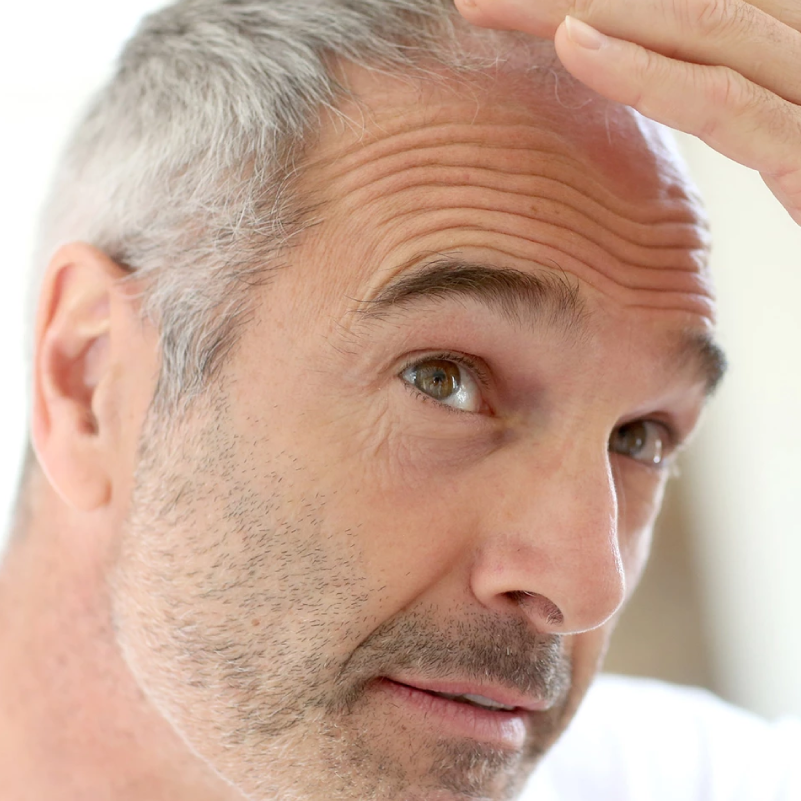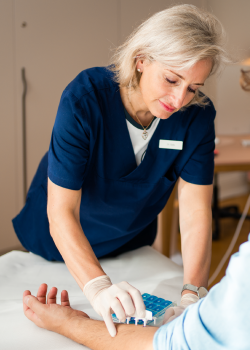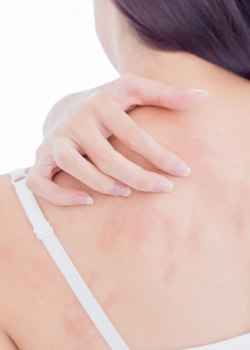Detailed Medical History
| Your Medical Background, Nutrition, and Hormones
|
|---|---|
Scalp Examination & Dermatoscopy
| Precise Analysis of Hair Roots and Scalp
|
Photodocumentation
| Standardized Images for Objective Progress Monitoring
|
Blood Test | Assessment of Ferritin, Zinc, Vitamin D, Thyroid Values, and More
|
|---|---|
Trichoscan
| High-Resolution Scalp and Hair Root Analysis
|
Choice of Therapy
| We select the treatment according to the diagnosis |
Not all hair loss is the same and therefore requires tailored therapies. We naturally take this into account in the diagnosis during our hair consultation and adjust the subsequent treatment accordingly.²
Types of Hair Loss:

Hereditary and hormonally induced hair loss is the most common form and results from a genetic sensitivity to the hormone dihydrotestosterone (DHT). The hair follicles shrink, the hair becomes finer, and growth slows down. Early therapy can significantly slow down this process and reactivate follicle activity.
In this case, hair falls out evenly over the entire scalp. Common triggers are stress, hormonal changes, infections, medications, or deficiencies. In most cases, this form is reversible. Once the underlying cause is identified and treated in our hair consultation, hair growth usually returns to normal.
This circular hair loss is an autoimmune disease in which the immune system attacks the hair roots. This leads to the characteristic round, sharply defined bald patches.³ However, the hair follicles remain intact, allowing for the possibility of regrowth. This requires the correct diagnosis followed by appropriate therapy.
When many hairs enter the resting phase simultaneously after infections, surgery, hormonal fluctuations, or severe stress, we speak of reactive hair loss. It usually appears two to three months after the actual trigger but is temporary and therefore reversible. In our hair consultation, we also support natural regrowth.
So-called cicatricial alopecia occurs due to inflammatory or autoimmune processes that permanently destroy the hair follicles. This destruction leads to scar tissue replacing healthy skin, preventing new hair growth. However, with timely diagnosis in our Hamburg hair consultation, inflammation can be stopped.
We speak of mechanically induced hair loss when prolonged tension from tight hairstyles, extensions, or frequent straightening damages the hair follicles. Initially, the scalp reacts with inflammation, redness, or itching. If the strain persists, the follicles atrophy. When recognized early, full regeneration of the scalp and hair is usually possible.
To ensure that no detail is overlooked, each hair consultation follows a clearly structured procedure. It begins with the anamnesis, during which we discuss your medical history, hormonal situation, nutrition, medication intake, and lifestyle in detail.
Next comes the scalp examination with dermatoscopy. Under high magnification, hair roots and scalp can be precisely assessed, allowing typical patterns of various forms of hair loss, inflammation, or scarring to be detected early. Our photodocumentation records the initial findings for ongoing progress monitoring.
To further clarify the causes, we conduct laboratory tests. Blood values such as ferritin, zinc, vitamin D, folic acid, B12, and thyroid hormones are checked to reliably identify deficiencies or hormonal influences. In addition, the Trichoscan analysis provides precise data on hair density, growth rate, and follicle activity — a computer-assisted measurement that makes the course and effect of the therapy measurable.
These active ingredients are applied externally and act directly on the scalp. Preparations containing minoxidil, finasteride, dutasteride, or alfatradiol improve circulation, inhibit DHT, extend the hair growth phase, and form the basis for successful long-term therapy. The formulations can also be supplemented with peptides, melatonin, or plant extracts.
When hormonal or inflammatory influences are present, systemic therapies that act internally are used. Finasteride, dutasteride, or oral minoxidil are suitable agents to regulate hormone activity and circulation. Especially in women, spironolactone or cyproterone acetate can help balance hormonal imbalances.
In inflammatory or autoimmune forms such as alopecia areata, we use targeted medications in the hair consultation. JAK inhibitors (e.g. baricitinib, ritlecitinib) block misdirected immune responses, while biologics such as dupilumab or adalimumab regulate inflammatory processes. These treatments are also individually tailored and carefully monitored.
Regenerative methods serve to activate the scalp’s self-healing power, improve its overall condition, and thereby stimulate hair growth. These include PRF autologous blood treatments, polynucleotides, exosome therapy, and Regenera Activa®, while procedures such as LaseMD® with KeraFactor® open microchannels for growth factors and peptides.
In addition to the correct diagnosis and selection of the appropriate therapy, regular check-ups in the Hamburg hair consultation ensure treatment success. After 3, 6, and 12 months, progress, hair structure, and growth rate are reassessed, if necessary with Trichoscan or photodocumentation. This allows us to continuously adjust the therapy and stabilize the results.
Focus on a protein-rich, balanced diet with essential micronutrients, sufficient sleep, physical activity, and stress reduction.⁴
Use pH-neutral shampoos and treat your hair gently. Scalp massages promote blood circulation and improve the absorption of nourishing active ingredients.
Low-level laser (LLLT) or LED caps stimulate the cellular activity of hair follicles. Their use supports other therapies and promotes scalp regeneration.
Hair loss is not merely a cosmetic issue. It is a sign of a systemic condition and can deeply affect a patient’s well-being. Therefore, our hair consultation combines precise diagnosis with a treatment concept tailored to each individual. The earlier you join us in identifying the causes of your hair loss, the more effectively we can help you.
If you wish for fuller, stronger hair, we are happy to support you with medical expertise, modern procedures, and honest guidance — step by step toward greater well-being.
Schedule your appointment for our hair consultation conveniently online or by phone – we are here for you.




Doctors with Heart and Experience
Modern Dermatology & Aesthetics
Heilwigstraße 33, 20249 Hamburg
We use cookies to optimize our website and our service.
Under settings, you will find detailed information and can make your choices. You can revoke or adjust your selection at any time in the cookie manager at the bottom right of the page.